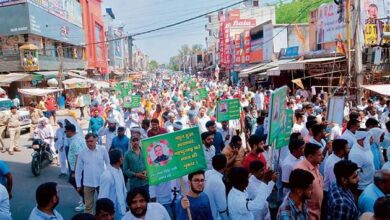Caste system in the Congress vocabulary
Rahul Gandhi, the Congress leader, has once again injected “social justice politics” into the election environment with his repeated calls for surveys on wealth redistribution and an expansion of caste quotas. His slogan is “Jitni Abadi, Utna Haq” (rights proportionate to population).

Despite vigorously advocating for welfarism and caste census during the most recent state elections in the Hindi heartland, the establishment party was unable to connect with the public.
However, the Congress platform places a strong emphasis on “social justice and equity,” readjusting its tactics for the Lok Sabha elections. The party has pledged in its platform to carry out a Socio-Economic and Caste Census in order to count the number of castes and sub-castes as well as their socio-economic circumstances. The party has promised to enact a constitutional change eliminating the Supreme Court-mandated 50% ceiling on reservations for SCs, STs, and OBCs in the event that the Opposition coalition wins power.
“To find out how many individuals are members of Scheduled Castes, Scheduled Tribes, Other Backward Classes, and Minorities, we shall first undertake a caste census throughout the country. Then, in a historic move to determine the distribution of wealth, we will carry out a financial and institutional assessment, Rahul Gandhi recently said.
Caste census: Congress issues “Nyay Patra,” a manifesto that calls for the restoration of J&K’s sovereignty and a caste census.
The opposition parties point out that even if the Mandal Commission estimates that 52% of OBCs are OBCs, the backward community’s numerical strength must have increased significantly yet they are still excluded from affirmative action. An opposition politician cites the findings of the Bihar government’s latest caste census as an example.
Based on the caste survey, the total number of OBCs in Bihar is 63%, which is 11% more than the numbers from the 1931 caste census.
In addition to having a rapidly expanding economy, we feed 83 crore people for free. We need to act more correctly if we are to comprehend the deprivation levels. The government may include more questions on people’s socioeconomic standing in the next census, according to Rajiv Gowda, the chairman of the AICC research wing and a former Congress MP.
In agreement, former chief minister of Karnataka Verappa Moily told this newspaper that a caste census is essential because it would show the true socioeconomic status of every community in the nation. Based on the updated figures, reservation limits will need to be increased, according to Moily. The findings of the Socioeconomic Caste Census, which was carried out in 2015 by the Karnataka Congress administration, have not yet been made public. “If there is a constitutional change, quotas may be expanded. Tamil Nadu has exceeded the 50% quota, Moily continued. Legal experts predict that the lifting of the Supreme Court’s 50% reservation limit would raise difficult constitutional challenges.
In the landmark Indira Sawhney ruling of 1992, the Supreme Court declared that the country’s maximum percentage of reservations could not surpass fifty percent. The SC did note that, in some extraordinary cases, the limit may be exceeded to the advantage of those living in distant places. The court has invalidated some states’ quotas that they had implemented to appease politically vocal caste groups, despite the fact that they had gone above the maximum limit set by the Supreme Court.
The Maharashtra government’s attempt to grant a Maratha quota over the 50% cap was declared unlawful by the Supreme Court in 2021, citing insufficient evidence of an exceptional circumstance.
Census of Castes
Economic mapping and caste censuses will “uproot” the 50% reservation limit: Gandhi Rahul
Even though a lot of state governments want to raise quotas over 50%, the high courts in Rajasthan and Orissa have rejected these attempts.
While the SC maintained the 10% reservation for Economically Weaker Sections (EWS), constitutional law expert Prof. G Mohan Gopal contends that there should be no connection between the EWS ruling and raising caste quotas.
According to Prof. Gopal, further actions are required to extend reservations to all job levels and sectors.
“Let’s contextualize the problem. Dr. Ambedkar warned a century ago that an oligarchy of four tiny clans still dominated India’s wealth and power. In order to eliminate the oligarchy, Dr. Ambedkar suggested a direct relationship between representation and reservation, which would include continuously raising and lowering reserve as necessary to provide fair and sufficient representation of all groups without walls or floors. A representative government has not been established under the existing reservation system. Eliminating the legally mandated 50% cap won’t guarantee representation on its own. According to Gopal, a former director of the National Judicial Academy, “more is required, including a social census, connecting reservations to representation directly, and broadening the scope of reservations to all levels and areas of employment.”
Experts claim that the Supreme Court has not yet rendered a decision about TN’s quota of 69%, despite Congress’ declaration that it would use the Ninth Schedule of the Constitution to raise the quota and replicate the Tamil Nadu quota matrix. A list of federal and state laws that are immune to legal challenge is included in the Ninth Schedule.
A measure to keep the state’s reservation at 69% was enacted in 1993 by the Tamil Nadu chief minister at the time. Later, the President approved the law. The Supreme Court has not yet made a decision in the lawsuits that are currently before it that contest the Act’s placement in the Ninth Schedule.







